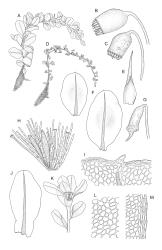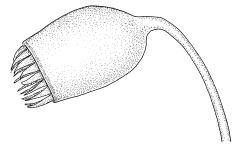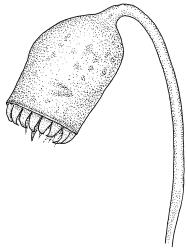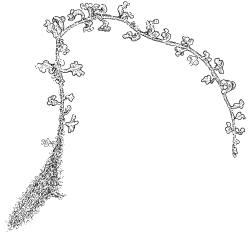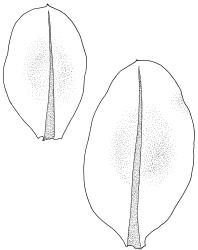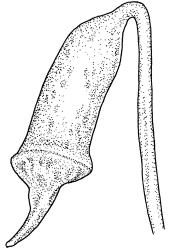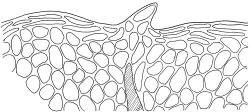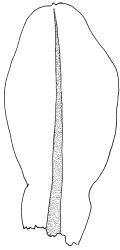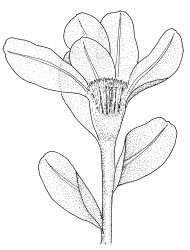- ≡ Mnium novae-zealandiae Colenso, Trans. & Proc. New Zealand Inst. 18: 225 (1886)
- ≡ Orthomnion novae-zealandiae (Colenso) T.J.Kop. & YuSun, J. Bryol. 39: 33 (2016)
- = Mnium xanthocarpum Colenso, Trans. & Proc. New Zealand Inst. 20: 238 (1888)
Mnium longirostrum sensu Sainsbury 1955
Mnium rostratum sensu Scott & Stone 1976
Plants mostly robust, bright to dark green, usually with plagiotropic and arching vegetative shoots, with leaves strongly contorted when dry. Stems pale brown, angular in cross-section, with thick-walled cortical cells and a well-developed central strand, beset below with red-brown and nearly smooth rhizoids, those of erect fertile shoots to c. 30 mm, those of sterile arching shoots to at least 80 mm. Leaves of fertile shoots broadly elliptic, undulate, strongly contorted when dry, often ± retuse and weakly mucronate at apex, bordered from insertion to apex by elongate cells, weakly and bluntly toothed from c. mid leaf or nearly entire, decurrent, mostly 5.5–7.0 × 3–4 mm. Leaves of arching shoots in two rows, as fertile shoots but smaller (especially near the stem base), lacking decurrencies. Mid laminal cells (in leaves of fertile shoots) not arranged in ranks, rounded-hexagonal, firm-walled, very slightly thickened at corners, mostly 30–45 × 21–30 µm, becoming more compact near leaf apex and more oblong and larger towards insertion; cells of the border elongate, thick-walled, in a single layer, and forming a border 3–4 cells and c. 45–60 µm wide at mid leaf. Costa stout, dilated towards insertion, fading just below apex, sometimes appearing to fuse with a very weak mucro, in cross-section rounded on both surfaces, with numerous large central cells surrounded on both sides by smaller, firm-walled cells and with a small adaxial stereid group, cells elongate in adaxial surface view.
Synoicous. Perichaetia terminal, conspicuous, surrounded by a whorl of wide-spreading leaves and reduced inner leaves, surrounding large numbers of archegonia, antheridia, and filiform 6–10-celled hyaline paraphyses. Setae single or multiple (–4) per perichaetium, yellow- or pale red-brown, erect and elongate, mostly 22–27(–40) mm; capsules inclined, horizontal, or weakly nutant, obovoid with a scarcely differentiated neck, pale brown with a red-brown rim, 3.0–4.0 mm long; exothecial cells irregular; stomata distributed on urn, immersed, sparse and difficult to observe; annulus apparently not differentiated; operculum rostrate from a conic base, c. ½ the length of capsule. Exostome teeth yellow-brown, finely papillose throughout (on outer surface), not bordered, lacking marginal trabeculae, with a zig-zag line on outer surface, strongly trabeculate and apparently otherwise smooth on inner surface; endostome with a high basal membrane, perforate segments, and 2–4 well-developed nodose or appendiculate cilia. Calyptra cucullate. Spores mostly 24–30 µm, pale brown, thin-walled and often collapsed in dried material.
Sainsbury 1955, pl. 42, fig. 1 (as Mnium longirostrum); Koponen 1983, figs 1–4; Beever et al. 1992, fig. 44; Malcolm & Malcolm 2003, p. 50.
Plagiomnium novae-zealandiae is regionally most likely to be confused with Achrophyllum dentatum, a species that often grows in the same habitats. Both these species have strongly contorted leaves when dry, and both can assume a dark, nearly black coloration. When the plants are moist, confusion is less likely.
NI: N Auckland, S Auckland, Gisborne, Hawke’s Bay, Wellington; SI: Nelson, Marlborough, Canterbury, Westland, Otago, Southland (Fiordland N.P.). No material from Taranaki L.D., Stewart I., or any of the southern offshore (subantarctic) islands has been confirmed. The lack of Taranaki L.D. records is likely a collection artefact.
Australasian. Mainland Australia* (Reported from Queensland, N.S.W., and Victoria by Wyatt & Ramsay 2012). Dalton et al. (1991) rejected the record of this species from Tasmania.
Usually at the margins of streams, rivers, or lakes, but often in wet sites on forest floors. Nearly always in sites that are irrigated or subject to flooding, and sometimes collected from areas of standing water; occasionally on prostrate logs or epiphytic. It can grow in alpine regions in sheltered sites, such as dolines on Mt Arthur (Nelson L.D.); all occurrences from above 1000 m are associated with calcareous rocks. Wyatt & Ramsay (2012) consider this species to be primarily high elevation (above 1000 m) and calcicolous in Australia, but the species is more catholic in its habitat preferences in NZ. Achrophyllum dentatum, Brachythecium plumosum, Fissidens rigidulus, Pohlia cruda, Racopilum strumiferum, Thuidium laevigatum, and Tridontium tasmanicum are frequently associated species.
On the North I. ranging from 10 m (Wairarapa Lake Shore Scenic Reserve, Wellington L.D.) to at least 750 m (Lake Waikaremoana, Gisborne L.D. and Mt Tongariro, Wellington L.D.). On the South I. from 10 m (near mouth of Wanganui River, Westland L.D.) to nearly 1600 m (Mt Arthur, Nelson L.D.)
The collection site of the lectotype of Mnium novae-zealandiae Colenso, given in the protologue as "Glenross", is probably the Glenross Homestead, located some 10 km SW of Pongaroa in Hawke’s Bay L.D.
The protologue of Mnium xanthocarpum Colenso cites only a single collection as type material, and thus Koponen’s (1983, p. 101) citing of the collection in WELT as a syntype is superfluous. Apparently duplicates of this collection were sent by Colenso to both Kew and to F.M. Reader, but only material in WELT has been seen.
Mnium novae-seelandiae Müll.Hal. is a nom. nud. Original material of M. novae-seelandiae Müll.Hal. was collected by R. Helms at Greymouth, but it does not appear to be present in any N.Z. herbarium. The original material (NY 01186706) can be viewed on JSTOR (accessed 8 March 2018) and has been annotated by T. Koponen.
Koponen (1982) indicated that P. novae-zealandiae closely resembles the South African P. rhynchophorum var. reidii within the section of Plagiomnium (sect. Rostrata (Kindb.) T.J. Kop.) to which these taxa are both assigned.




